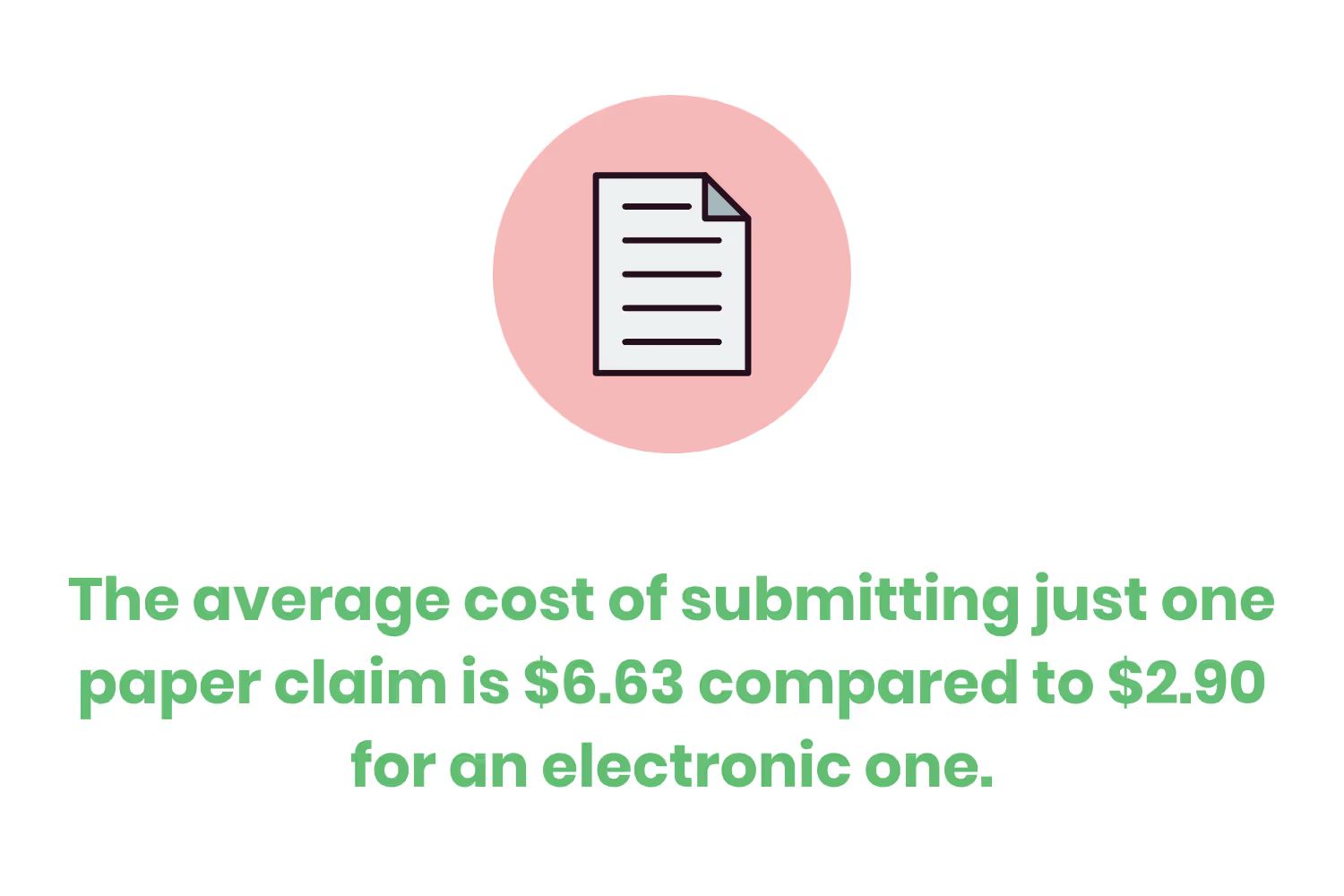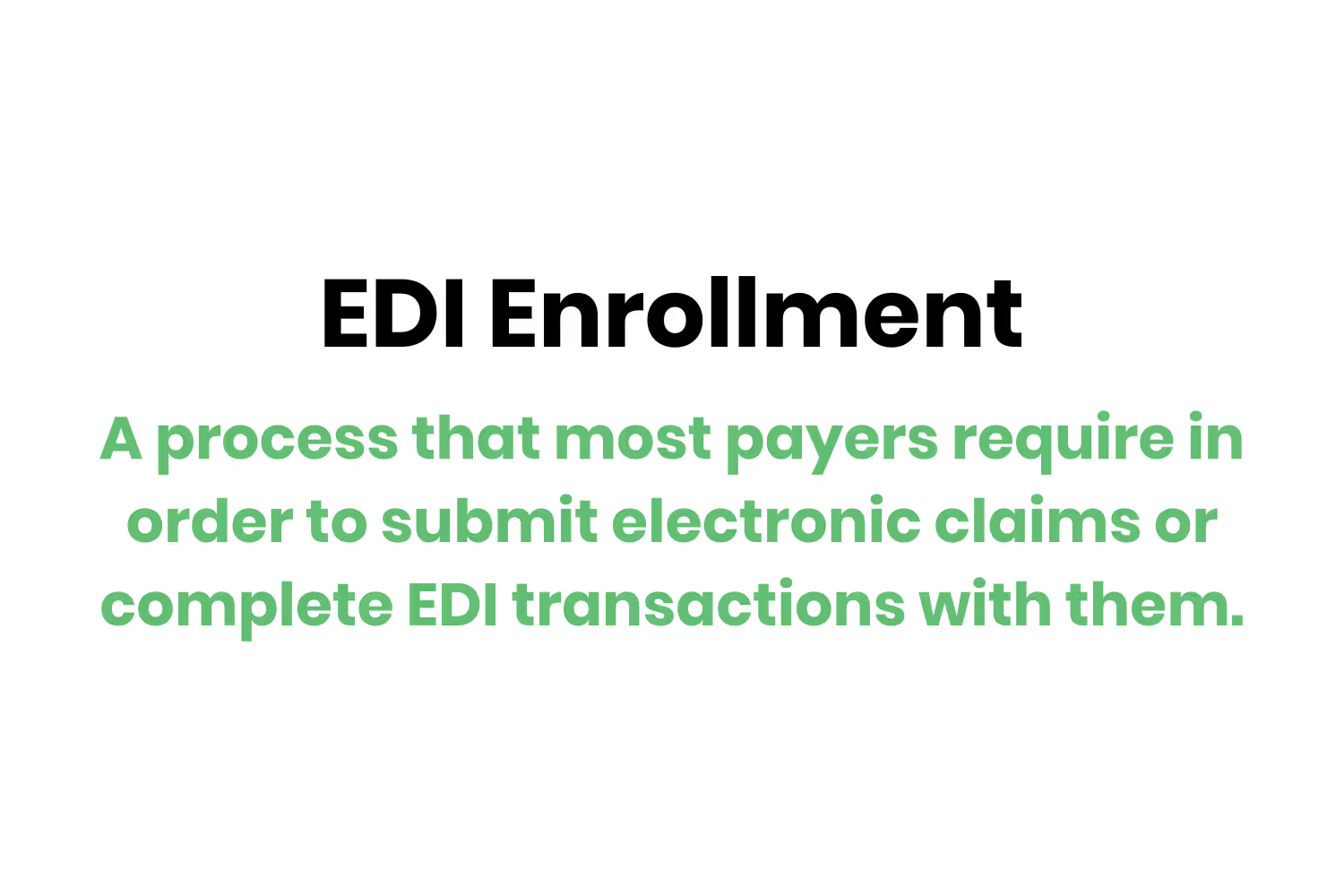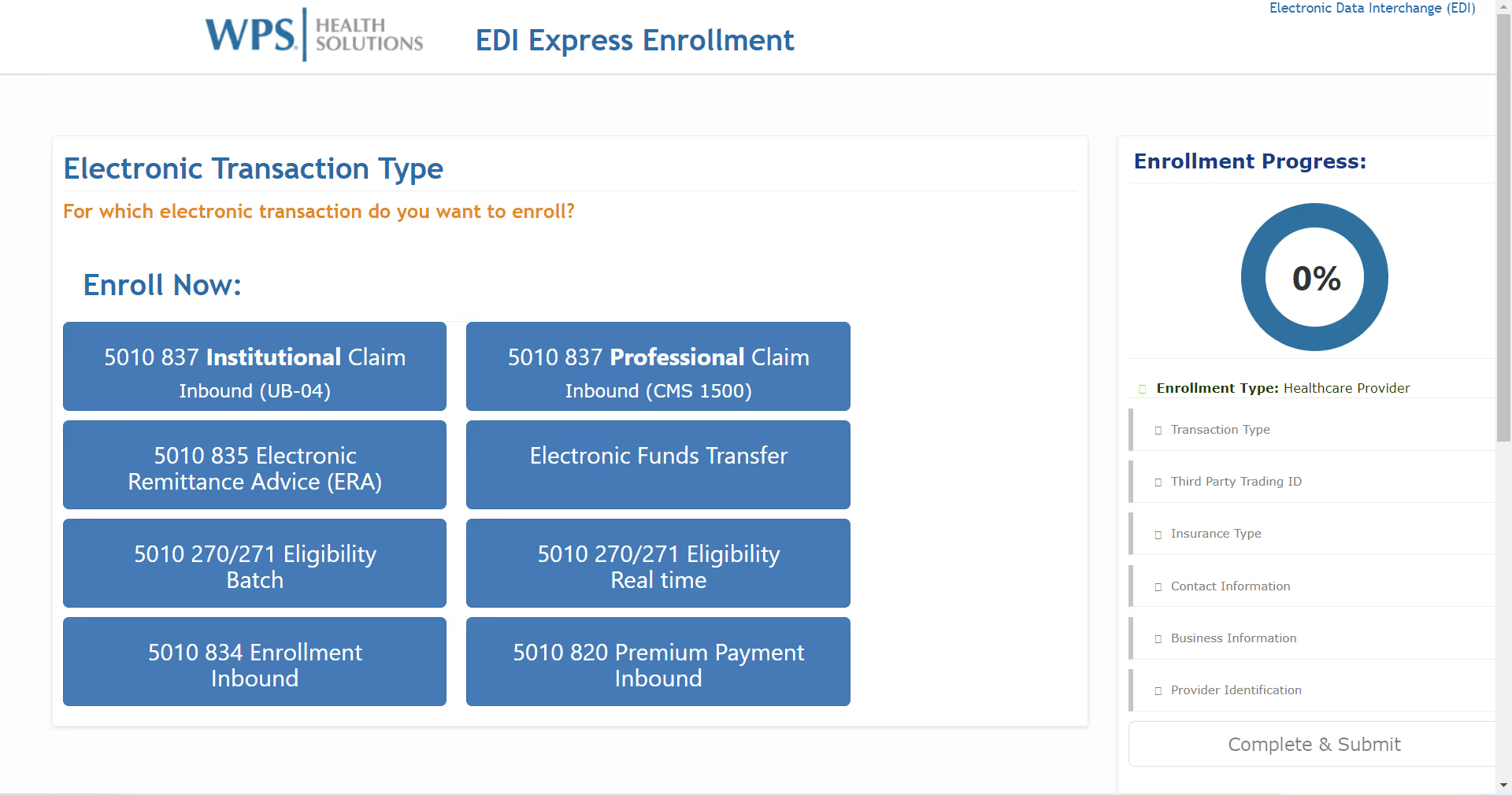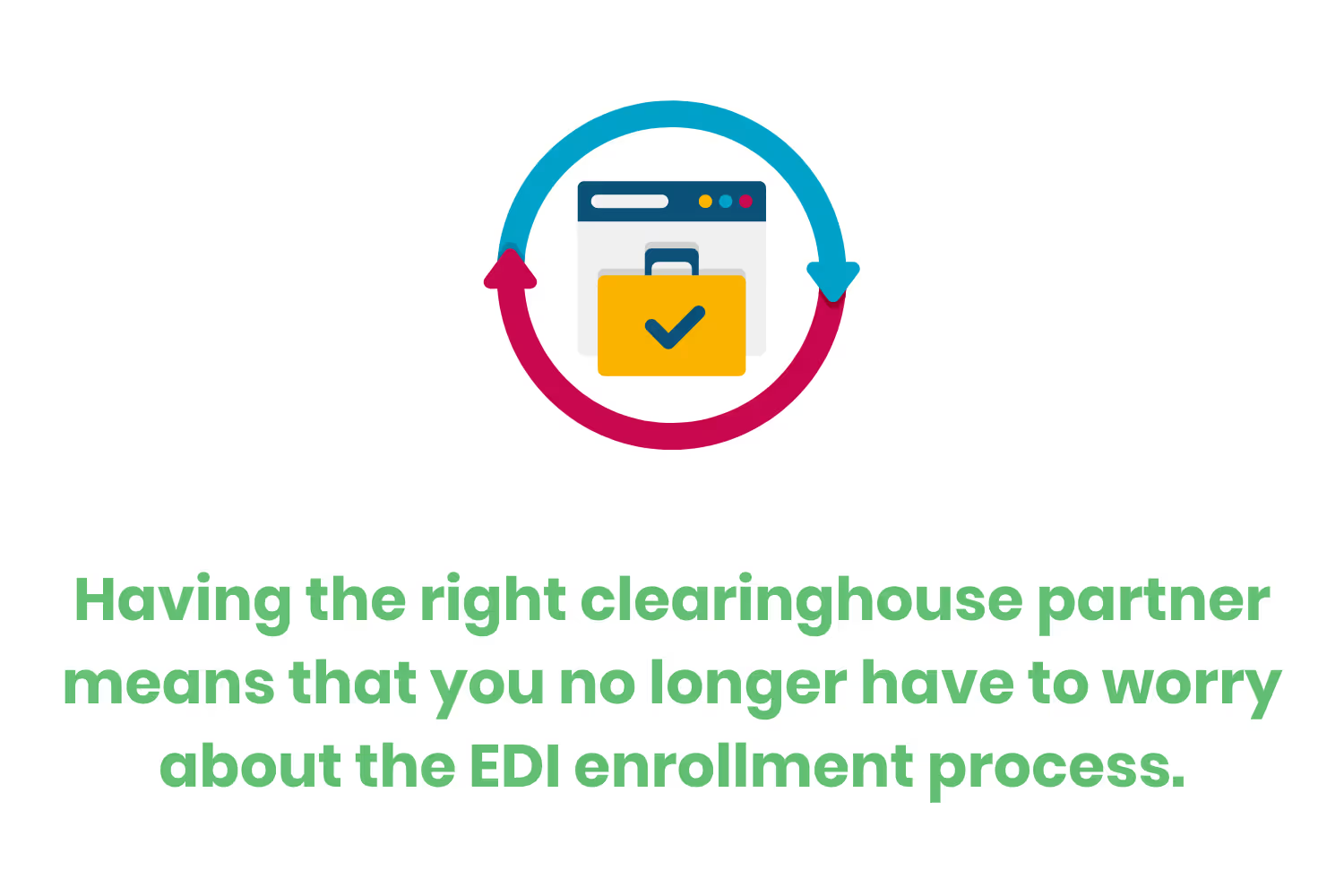EDI Enrollment: Everything You Need to Know
Every provider knows that working with payers is a super easy and straightforward process. So, that means that EDI enrollment is easy, right? I’m being facetious. Here is our ultimate guide to the EDI enrollment process and how to streamline it.

The introduction of the electronic claims process revolutionized healthcare forever.
In the past, paper-based systems plagued healthcare organizations with inefficiencies and inaccuracies.
The paper claim process was so clunky that the average cost of submitting just one of them was $6.63. For comparison, the average cost of submitting a claim electronically is $2.90.
Fast forward to the current claim submission landscape and almost 90% of doctor’s offices use some form of electronic health record (EHR) system.

That’s great news, especially after I just pointed out the 56% savings experienced with the use of electronic claims.
But switching to electronic claims doesn’t cut down on the payer requirements. Submitting the claims is still a step that needs to happen. Electronic doesn’t mean automated.
Also, you can’t just send your electronic claims all willy-nilly to payers when you switch either. There’s a preliminary step that every payer requires called Electronic Data Interchange (EDI) enrollment.
Every provider knows that working with payers is a super easy and straightforward process. So, that means that EDI enrollment is easy, right? I’m being facetious.
Here is our ultimate guide to the EDI enrollment process and how to streamline it.
What is EDI Enrollment?
Working with payers is one of the hardest aspects of running a modern healthcare organization.
There’ve been opinion pieces written implicating that payers might be one of the lead reasons why physicians experience such high rates of burnout.
The truth is, EDI enrollment is a process that you’re already familiar with…it’s just in a different format.
Think about the paper claim submission process. Insurance payers traditionally accepted CMS 1500 or UB-04 paper claim forms. Back when paper claims were the standard, healthcare providers hired employees whose sole responsibility was to fill out and mail these forms. What a pain, right?

Here’s the problem…the modern process isn’t much easier if you’re doing it yourself.
EDI enrollment is a process that most payers require in order to submit electronic claims or complete EDI transactions with them.
In a perfect world, every payer would require the same process and you could accomplish enrollment en masse. How great would it be if you could just fill out one form and send it to all insurance payers? It’s not that easy.
You see, every payer has its own set of requirements for EDI enrollment. It honestly seems like no two enrollment processes are the same.
In other words, the employees who were responsible for filling out mailing paper claims are now responsible for accomplishing the enrollment process…except the new process triples their workload.
EDI Enrollment Process Example
In order to really understand what’s required from an enrollment perspective, let’s take a look at a real-world example from a payer.

In most cases, your EDI enrollment process starts by finding the process within the payer’s website. The example image above shows the webpage you would need to find to enroll with WPS Health Insurance.
From that page, you’d have to click on the “Enroll for EDI” button.

Once you click on the “Enroll for EDI” button, the website takes you to a spam-proof page.
What’s important to note from this next step is the notice at the bottom. WPS states that it takes up to 2 weeks to validate and process your enrollment with them. Keep in mind that this phase is just for enrollment…you haven’t even gotten to the point where you can send your claims to WPS.

Navigating past the spam-proof page officially kicks off WPS’ enrollment process and it’s intimidating. There are 6 different steps involved, all specific to WPS’ requirements.
And this enrollment process is only for one payer. Unless you’re located in Wisconsin, the chances that you see another patient that has WPS as their insurance provider is extremely low.
So from a business perspective in this example, does it even make sense to pursue enrolling with WPS? Or, should you just cut your losses and write off this patient’s claim?
That’s the dilemma that many healthcare organizations find themselves in.
EDI Enrollment and Clearinghouses
After taking a look at a real-world example of a payer’s EDI enrollment process. You’re probably feeling pretty bummed right now. I mean, navigating from payer to payer and completing each of their processes costs a lot of your organization’s resources.
Luckily, there are organizations that exist with the sole purpose of getting you enrolled with all of your patients’ payers.
Of course, the “organizations” I’m referring to are clearinghouses.
You see, clearinghouses exist as a middleman for healthcare organizations to streamline their back-and-forth communication with payers. Clearinghouses (like Etactics) already have the proper connections established with all of the payers you need.

In other words, your clearinghouse partner should be able to automate your entire claim submission process and help you collect on the same, without disrupting your daily tasks. After all, healthcare organizations’ main goal is to take care of their patients.
Thus, once you’re integrated with a clearinghouse your process is much simpler and it looks something like this…
- A patient has an appointment at your organization with Hometown Insurance.
- You submit the claim to your clearinghouse partner.
- The clearinghouse auto-enrolls your organization with Hometown Insurance and submits the patient’s claim.
In other words, having the right clearinghouse partner means that you no longer have to worry about the EDI enrollment process at all. What a relief.
Benefits of Clearinghouse EDI Enrollment
What exactly are the benefits of sourcing a clearinghouse for your EDI enrollment needs?
Benefit 1: Decrease in Administrative Tasks
The first and most obvious benefit to using a clearinghouse for EDI enrollment is that it decreases your administrative tasks.
I hinted at this benefit at the end of the previous main section, but any process that’s required by a payer that you can outsource is a win for your employees.
Since essentially every payer now requires electronic claim submission, it also means that they demand your organization to go through their enrollment process.
Take the time the process that I walked you through earlier with WPS takes and multiply it by how many different insurances your patients use. That’s a lot of administrative tasks.
But the right clearinghouse partner takes all of that work off your shoulders.
Benefit 2: Cost-Effective
If you don’t have a clearinghouse partner, it means you’re manually working through the EDI enrollment process with every payer that your patients use.
That administrative burden is a huge investment of your organization's resources. To make matters worse, that burden increases as your organization grows.
Although there is an investment involved with choosing a clearinghouse, the cost is offset in your favor because it streamlines all of the clunky, administrative tasks (including enrollment).
Benefit 3: On-Time Payments
Do you remember in the section of this blog post where I walked through WPS’ enrollment process?
During that process, WPS had a landing page that mentioned it would take at least 2 weeks to evaluate and approve your organization’s enrollment.
The page looked like this…

In other words, if you’re manually going through each payer’s enrollment process…it takes a lot of time.
It takes time for your employee to fill out the proper enrollment forms for each payer AND it takes time for the payer to review and approve the submission. Realistically, let’s say that takes 3 weeks or 15 business days.
15 days have gone by since the patient’s appointment and you haven’t even been able to submit their claim yet.
Meanwhile, payers place timely filing limits on claim submissions meaning that if you submit a claim past their limit…chalk it up as a denial.
Since clearinghouses already have established connections with most payers, it saves you all of that time you lose through manual work.
Benefit 4: Automated Data-Entry
Let’s say that your healthcare organization existed in a rural area for over a decade. Over time, that area experienced a surge in community development which increased the town's population. The increase in population led to more patients visiting your practice. Your small facility became overcrowded so you had to move locations.
If you didn’t have a clearinghouse partner, one of the tasks that someone on your team would have to do is update the address change in every payer’s enrollment database.
That’s a large, tedious task that if you didn’t complete quickly would result in claim submission discrepancies…ultimately leading to denials.
An often overlooked benefit of a clearinghouse is the ability to push out organizational updates across all payer databases. Saving you more organizational resources.
Conclusion
Although electronic claim submission has been the standard since the Health Insurance Portability and Accountability Act’s (HIPAA) final rule in 2000, it’s still a learning process for many healthcare organizations.
Yes, electronic claim submission is a more efficient and more secure way to collect from payers. But, its processes aren’t easier than paper claim submission from a manual perspective. EDI enrollment is one of those processes.
That’s where clearinghouses come in. The right clearinghouse partner is a cost-effective way to cut down on your administrative tasks and ensure on-time payments.
Etactics is one such clearinghouse. We help take the manual tasks off of your shoulders like EDI enrollment so that you can focus on why your healthcare organization exists…to care for the patients that walk through your doors.
Emphasize your product's unique features or benefits to differentiate it from competitors
In nec dictum adipiscing pharetra enim etiam scelerisque dolor purus ipsum egestas cursus vulputate arcu egestas ut eu sed mollis consectetur mattis pharetra curabitur et maecenas in mattis fames consectetur ipsum quis risus mauris aliquam ornare nisl purus at ipsum nulla accumsan consectetur vestibulum suspendisse aliquam condimentum scelerisque lacinia pellentesque vestibulum condimentum turpis ligula pharetra dictum sapien facilisis sapien at sagittis et cursus congue.
- Pharetra curabitur et maecenas in mattis fames consectetur ipsum quis risus.
- Justo urna nisi auctor consequat consectetur dolor lectus blandit.
- Eget egestas volutpat lacinia vestibulum vitae mattis hendrerit.
- Ornare elit odio tellus orci bibendum dictum id sem congue enim amet diam.
Incorporate statistics or specific numbers to highlight the effectiveness or popularity of your offering
Convallis pellentesque ullamcorper sapien sed tristique fermentum proin amet quam tincidunt feugiat vitae neque quisque odio ut pellentesque ac mauris eget lectus. Pretium arcu turpis lacus sapien sit at eu sapien duis magna nunc nibh nam non ut nibh ultrices ultrices elementum egestas enim nisl sed cursus pellentesque sit dignissim enim euismod sit et convallis sed pelis viverra quam at nisl sit pharetra enim nisl nec vestibulum posuere in volutpat sed blandit neque risus.

Use time-sensitive language to encourage immediate action, such as "Limited Time Offer
Feugiat vitae neque quisque odio ut pellentesque ac mauris eget lectus. Pretium arcu turpis lacus sapien sit at eu sapien duis magna nunc nibh nam non ut nibh ultrices ultrices elementum egestas enim nisl sed cursus pellentesque sit dignissim enim euismod sit et convallis sed pelis viverra quam at nisl sit pharetra enim nisl nec vestibulum posuere in volutpat sed blandit neque risus.
- Pharetra curabitur et maecenas in mattis fames consectetur ipsum quis risus.
- Justo urna nisi auctor consequat consectetur dolor lectus blandit.
- Eget egestas volutpat lacinia vestibulum vitae mattis hendrerit.
- Ornare elit odio tellus orci bibendum dictum id sem congue enim amet diam.
Address customer pain points directly by showing how your product solves their problems
Feugiat vitae neque quisque odio ut pellentesque ac mauris eget lectus. Pretium arcu turpis lacus sapien sit at eu sapien duis magna nunc nibh nam non ut nibh ultrices ultrices elementum egestas enim nisl sed cursus pellentesque sit dignissim enim euismod sit et convallis sed pelis viverra quam at nisl sit pharetra enim nisl nec vestibulum posuere in volutpat sed blandit neque risus.
Vel etiam vel amet aenean eget in habitasse nunc duis tellus sem turpis risus aliquam ac volutpat tellus eu faucibus ullamcorper.
Tailor titles to your ideal customer segment using phrases like "Designed for Busy Professionals
Sed pretium id nibh id sit felis vitae volutpat volutpat adipiscing at sodales neque lectus mi phasellus commodo at elit suspendisse ornare faucibus lectus purus viverra in nec aliquet commodo et sed sed nisi tempor mi pellentesque arcu viverra pretium duis enim vulputate dignissim etiam ultrices vitae neque urna proin nibh diam turpis augue lacus.



![[ANSWERED] What is a Long-Term Care (LTC) Pharmacy](https://cdn.prod.website-files.com/67e2b8210878abcba6f91ae6/68d687806a075a1cf64659b0_WhatisLongTermCarePharmacy_925.avif)
